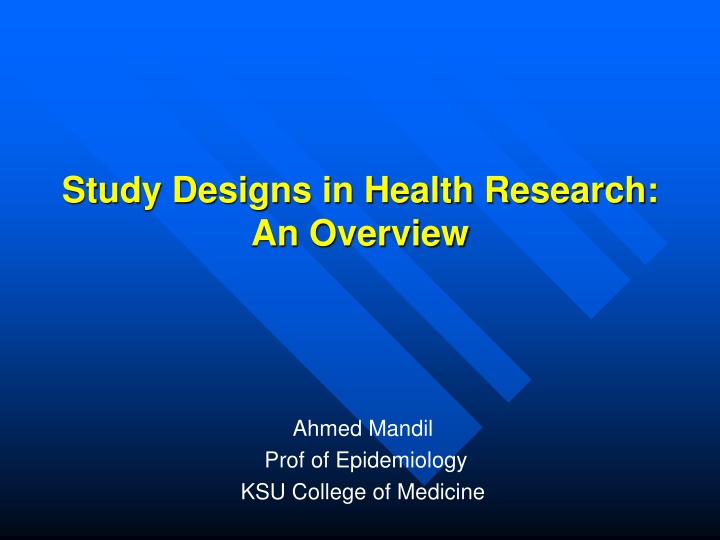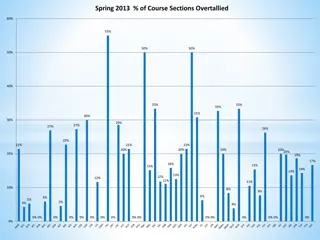
Overview of Study Designs in Health Research by Ahmed Mandil
Explore the classification of study designs, qualitative and quantitative methods, and the choice of study design in health research. Understand the different types of research including lab research, population-based research, and healthcare facility research. Learn about primary and secondary data collection methods, study design definitions, and types of study designs. Dive into qualitative designs and comparison of qualitative and quantitative methods.
Download Presentation

Please find below an Image/Link to download the presentation.
The content on the website is provided AS IS for your information and personal use only. It may not be sold, licensed, or shared on other websites without obtaining consent from the author. If you encounter any issues during the download, it is possible that the publisher has removed the file from their server.
You are allowed to download the files provided on this website for personal or commercial use, subject to the condition that they are used lawfully. All files are the property of their respective owners.
The content on the website is provided AS IS for your information and personal use only. It may not be sold, licensed, or shared on other websites without obtaining consent from the author.
E N D
Presentation Transcript
Study Designs in Health Research: An Overview Ahmed Mandil Prof of Epidemiology KSU College of Medicine
Headlines Health research Classification of study designs Qualitative methods Quantitative methods Choice of study design
Health Research Lab research: applies knowledge of basic sciences towards development of procedures and strategies to prevent, control and understand mechanisms of health-related phenomena Population-based (field) research: study of distribution, determinants, control measures of health-related phenomena in chosen populations, followed by application of suitable biostatistical techniques which may allow generalization of results Healthcare-facility (clinical) research: application of epidemiological principles in research based in healthcare facilities, e.g. randomized clinical trials 18 March 2025 Study Designs Overview 3
Data Collection Methods Primary: where the investigator is the first to collect the data. Sources include: medical examinations, interviews, observations, etc. Merits: less measurement error, suits objectives of the study better. Disadvantage: costly, may not be feasible. Secondary: where the data is collected by OTHERS, for other purposes that those of the current study. Sources include: individual records (medical / employment); group records (census data, vital statistics) 18 March 2025 Study Designs Overview 4
Study design: Definition A study design is a specific plan or protocol for conducting the study, which allows the investigator to translate the conceptual hypothesis into an operational one. 18 March 2025 Study Designs Overview 5
Study Designs: Types Qualitative Quantitative Experimental Observational 18 March 2025 Study Designs Overview 6
Comparison (II) Comparison (II) Qualitative Methods Focus Groups Interviews Surveys Self-reports Observations Document analysis Sampling: Purposive Quality Assurance: Trustworthiness: Credibility, Confirmability, Dependability, Transferability Authenticity: Fairness, Ontological, Educative, Tactical, Catalytic Quantitative Methods Observational Experimental Mixed Sampling: Random (simple, stratified, cluster, etc) or purposive Quality Assurance: Reliability: Internal and External Validity: Construct, Content, Face 18 March 2025 Study Designs Overview 8
Qualitative Research Techniques Participant observation (field notes) Interviews / Focus group discussions with key infomants Video / Text and Image analysis (documents, media data) Surveys User testing 18 March 2025 Study Designs Overview 9
Involves Skills of Observing Conversing Participating Interpreting 18 March 2025 Study Designs Overview 10
Rigor in Qualitative Research Dependability Dependability Credibility Credibility Transferability Transferability Confirmability Confirmability 18 March 2025 Study Designs Overview 11
Quantitative designs Observational: studies that do not involve any intervention or experiment. Experimental: studies that entail manipulation of the study factor (exposure) and randomization of subjects to treatment (exposure) groups 18 March 2025 Study Designs Overview 13
Observation Methods Selected Units: individuals, groups Study Populations: cross-sectional, longitudinal Data collection timing: prospectively, retrospectively, combination Data collection types: primary, secondary 18 March 2025 Study Designs Overview 15
Study populations Cross-sectional: where only ONE set of observations is collected for every unit in the study, at a certain point in time, disregarding the length of time of the study as a whole Longitudinal: where TWO or MORE sets of observations are collected for every unit in the study, i.e. follow-up is involved in order to allow monitoring of a certain population (cohort) over a specified period of time. Such populations are AT RISK (disease-free) at the start of the study. 18 March 2025 Study Designs Overview 16
Observational Designs: Classification Exploratory: used when the state of knowledge about the phenomenon is poor: small scale; of limited duration. Descriptive: used to formulate a certain hypothesis: small / large scale. Examples: case-studies / series; cross-sectional studies Analytical: used to test hypotheses: small / large scale. Examples: case-control, cross- sectional, cohort. 18 March 2025 Study Designs Overview 17
Case Case- -series: series: Clinical case series Clinical case series Clinical case-series: usually a coherent and consecutive set of cases of a disease (or similar problem) which derive from either the practice of one or more health care professionals or a defined health care setting, e.g. a hospital or family practice. A case-series is, effectively, a register of cases. Analyse cases together to learn about the disease. Clinical case-series are of value in epidemiology for: Studying symptoms and signs Creating case definitions Clinical education, audit and research 18 March 2025 Study Designs Overview 18
Case series: Population based opulation based When a When a clinical case clinical case- -series defined geographical area for which the defined geographical area for which the population is known, it is, effectively, a population is known, it is, effectively, a population based case population based case- -series population register of cases. population register of cases. Epidemiologically the most important case Epidemiologically the most important case- - series are registers of serious diseases or series are registers of serious diseases or deaths (usually NCDs), and of health service deaths (usually NCDs), and of health service utilisation, e.g. hospital admissions. utilisation, e.g. hospital admissions. Usually compiled for administrative and legal Usually compiled for administrative and legal reasons. reasons. series is complete for a is complete for a series consisting of a consisting of a 18 March 2025 Study Designs Overview 19
Case series: Population Full epidemiological use of case Full epidemiological use of case- -series data needs information on the population to permit calculation information on the population to permit calculation of of rates rates Key to understanding the distribution of disease in Key to understanding the distribution of disease in populations and to the study of variations over time, populations and to the study of variations over time, between places and by population characteristics between places and by population characteristics Case Case- -series series can provide the key to sound case can provide the key to sound case control and cohort studies and trials control and cohort studies and trials Design of a case Design of a case- -series is conceptually simple series is conceptually simple Defines a disease or health problem to be studied Defines a disease or health problem to be studied and sets up a and sets up a system for capturing data on the system for capturing data on the health status and related factors in consecutive health status and related factors in consecutive cases cases series data needs 18 March 2025 Study Designs Overview 20
Case series: Requirements for interpretation To make sense of case To make sense of case- -series data the key requirements series data the key requirements are: are: The diagnosis (case definition) or, for mortality, the The diagnosis (case definition) or, for mortality, the cause of death cause of death The date when the disease or death occurred The date when the disease or death occurred (time) The place where the person lived, worked etc The place where the person lived, worked etc (place) The characteristics of the person The characteristics of the person (person) The opportunity to collect additional data from medical The opportunity to collect additional data from medical records (possibly by electronic data linkage) or the records (possibly by electronic data linkage) or the person directly person directly The size and characteristics of the The size and characteristics of the population at risk (time) (place) (person) population at risk 18 March 2025 Study Designs Overview 21
Case series: Strengths Population case Population case- -series permit two arguably unique series permit two arguably unique forms of epidemiological analysis and insight. forms of epidemiological analysis and insight. Paint a truly national and even international Paint a truly national and even international population perspective on disease population perspective on disease. . The disease patterns can be The disease patterns can be related to aspects of society or the environment society or the environment that affect the population but have no sensible measure at the population but have no sensible measure at the individual level e.g. ozone concentration at ground individual level e.g. ozone concentration at ground level and the thickness of the ozone layer in the level and the thickness of the ozone layer in the earth's atmosphere. earth's atmosphere. related to aspects of that affect the 18 March 2025 Study Designs Overview 22
Cross-sectional Studies (Community health studies, surveys) Characteristics: detects point prevalence; relatively common conditions; allows for stratification; different from surveillance / registers Merits: feasible; quick; economic; allows study of several diseases / exposures; useful for estimation of the population burden, health planning and priority setting of health problems Limitations: temporal ambiguity (cannot determine whether the exposure preceded outcome); possible measurement error; not suitable for rare conditions; liable to survivor bias Effect measure: Odds Ratio + CI 18 March 2025 Study Designs Overview 23
Case - Control Studies Characteristics: two source populations; assumption that non-cases are representative of the source population of cases. Merits: least expensive; least time-consuming; suitable for study of rare diseases (especially NCDs) Limitations: not suitable for rare exposures; liable to selection bias and recall bias; not suitable for calculation of frequency measures. Effect measure: Odds Ratio + CI 18 March 2025 Study Designs Overview 24
Cohort Studies Characteristics: follow-up period (prospective; retrospective) Merits: no temporal ambiguity; several outcomes could be studied at the same time; suitable for incidence estimation Limitations (of prospective type): expensive; time-consuming; inefficient for rare diseases; may not be feasible Effect measure: Risk Ratio (Relative Risk) + CI 18 March 2025 Study Designs Overview 25
disease Factor present no disease Study population free of disease disease Factor absent no disease present future time Study begins here 18 March 2025 Study Designs Overview 26
Ecological studies (I) Ecological studies (I) These are studies where exposure data relating to a These are studies where exposure data relating to a place (say hardness of water, which could be place (say hardness of water, which could be collected on individuals) are correlated with health collected on individuals) are correlated with health data collected on individuals but summarised by place data collected on individuals but summarised by place (say CHD rates). (say CHD rates). Conceptually, the ecological component in this kind of Conceptually, the ecological component in this kind of study is an issue of data analysis and not study study is an issue of data analysis and not study design design. What is missing: relationship between exposure and outcome at the individual level (incomplete design) 18 March 2025 Study Designs Overview 27
Ecological studies (II) Ecological studies (II) Cross Cross- -sectional, case sectional, case- -control and cohort studies and control and cohort studies and trials (and not just population case trials (and not just population case- -series) could also be analysed in relation to such "ecological" variables be analysed in relation to such "ecological" variables and such units of analysis. and such units of analysis. Most ecological analyses are based on Most ecological analyses are based on population case case- -series. series. Ecological analyses are subject to the ecological Ecological analyses are subject to the ecological fallacy. fallacy. series) could also population 18 March 2025 Study Designs Overview 28
Ecological fallacy: example Imagine a study of the rate of coronary heart disease in the capital cities of the world relating the rate to average income. Within the cities studied, coronary heart disease is higher in the richer cities than in the poorer ones. We might predict from such a finding that being rich increases your risk of heart disease. In the industrialised world the opposite is the case - within cities such as London, Washington and Stockholm, poor people have higher CHD rates than rich ones. The ecological fallacy is usually interpreted as a major weakness of ecological analyses. Ecological analyses, however, informs us about forces which act on whole populations. 18 March 2025 Study Designs Overview 29
Experimental Study Design A study in which a population is selected for a planned trial of a regimen, whose effects are measured by comparing the outcome of the regimen in the experimental group versus the outcome of another regimen in the control group. Such designs are differentiated from observational designs by the fact that there is manipulation of the study factor (exposure), and randomization (random allocation) of subjects to treatment (exposure) groups. 18 March 2025 Study Designs Overview 31
Why Performed ? 1. 1. Provide stronger Provide stronger evidence (outcome) compared to observational designs, (outcome) compared to observational designs, with maximum confidence and assurance with maximum confidence and assurance 2. Yield more Yield more valid results valid results, as variation is minimized and bias controlled minimized and bias controlled 3. Determine whether experimental treatments are Determine whether experimental treatments are safe and effective under safe and effective under controlled environments environments (as opposed to (as opposed to natural settings in observational designs), especially in observational designs), especially when the margin of expected benefit is doubtful / when the margin of expected benefit is doubtful / narrow ( narrow (10 10 - - 30 30%) %) evidence of the effect of the effect , as variation is 2. 3. controlled natural settings 18 March 2025 Study Designs Overview 32
outcome RANDOMIZATION Intervention no outcome Study population outcome Control no outcome baseline future time Study begins here (baseline point) Study Designs Overview 18 March 2025 33
Types of trials Trial Controlled Not controlled Randomised Not randomised Blinded Not blinded 18 March 2025 Study Designs Overview 34
Choice of Design (I) Depends on: Research Questions Research Goals Researcher Beliefs and Values Researcher Skills Time and Funds 18 March 2025 Study Designs Overview 35
Choice of design (II) It is also related to: Status of existent knowledge Occurrence of disease Duration of latent period Nature and availability of information Available resources 18 March 2025 Study Designs Overview 36
Conclusion Qualitative designs are complementary to quantitative designs, are important in study of social determinants of health problems Quantitative designs have a common goal to understand the frequency and causes of health-related phenomena Seeking causes starts by describing associations between exposures (causes) and outcomes 18 March 2025 Study Designs Overview 37
Headlines Health research Classification of designs Qualitative methods Quantitative methods Choice of design
References 1. Porta M. A dictionary of epidemiology. 5th edition. Oxford, New York: Oxford University Press, 2008. 2. Rothman J, Greenland S. Modern Second edition. Lippincott - Raven Publishers, 1998. 3. Bhopal R. Study design. University of Edinburgh. 4. NLM. An introduction to Clinical trials. U.S. National Library of Medicine, 2004 5. Songer T. Study designs in epidemiological research. In: South Asian Cardiovascular Research Methodology Workshop. Aga-Khan and Pittsburgh universities. Modern epidemiology epidemiology. 18 March 2025 Study Designs Overview 39
Thanks for your kind attention and listening



















